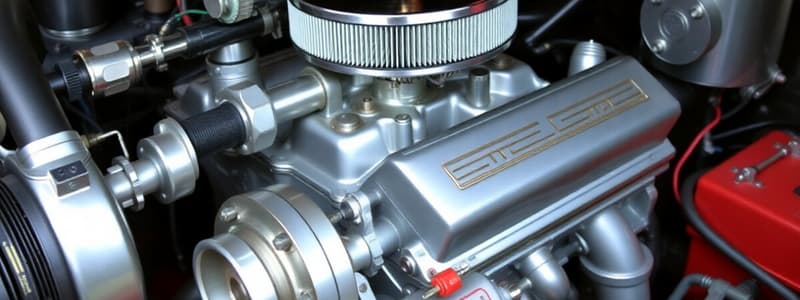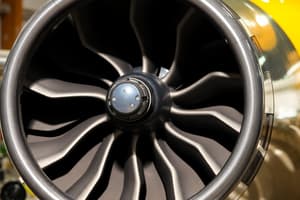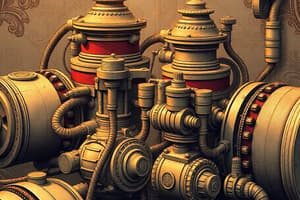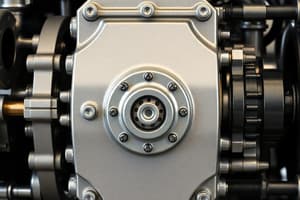Podcast
Questions and Answers
What should be done if a foam type air filter is found to be dirty?
What should be done if a foam type air filter is found to be dirty?
- Soak it in water to remove dirt before reinstalling.
- Replace it directly with a new filter without cleaning.
- Remove it, clean it, and recoat it with the recommended oil. (correct)
- Leave it as is since it does not affect engine performance.
What is a potential consequence of loose bolts and nuts in the system?
What is a potential consequence of loose bolts and nuts in the system?
- They help to stabilize the mounting system.
- They can cause a decrease in fuel efficiency.
- They improve engine performance by allowing better airflow.
- They may lead to serious damage if they enter the engine. (correct)
What should be checked to ensure the security of the system’s components?
What should be checked to ensure the security of the system’s components?
- The cleanliness of the cabin air.
- The fuel type and its compatibility with the engine.
- The mounting of units and tightness of bolts and nuts. (correct)
- The temperature of the engine during operation.
Why is it important to keep the system clean at all times?
Why is it important to keep the system clean at all times?
What should be done with the excess fluid after cleaning the filter element?
What should be done with the excess fluid after cleaning the filter element?
What occurs to the pressure of air as it passes through the throat of the venturi?
What occurs to the pressure of air as it passes through the throat of the venturi?
Which part of the carburetor directly influences airflow to the engine cylinders?
Which part of the carburetor directly influences airflow to the engine cylinders?
The differential pressure in a carburetor is crucial for which of the following?
The differential pressure in a carburetor is crucial for which of the following?
What is the relationship between air velocity and pressure in the venturi system?
What is the relationship between air velocity and pressure in the venturi system?
In carburetors that utilize venturi principles, what is the effect of the venturi throat on airflow?
In carburetors that utilize venturi principles, what is the effect of the venturi throat on airflow?
What is the primary function of the carburetor air ducts in the induction system?
What is the primary function of the carburetor air ducts in the induction system?
How does the ram-air intake assist the induction system?
How does the ram-air intake assist the induction system?
What aspect of the carburetor does the throttle plate control?
What aspect of the carburetor does the throttle plate control?
What do some engines have that indicates the temperature of the air at the carburetor inlet?
What do some engines have that indicates the temperature of the air at the carburetor inlet?
What can be inferred if the temperature bulb is located on the engine side of the carburetor?
What can be inferred if the temperature bulb is located on the engine side of the carburetor?
What is a common design feature of carburetor air ducts?
What is a common design feature of carburetor air ducts?
What is the effect of regulating manifold pressure through the throttle plate?
What is the effect of regulating manifold pressure through the throttle plate?
Which of the following statements best describes the carburetor's function in the induction system?
Which of the following statements best describes the carburetor's function in the induction system?
What is the effect of throttle ice on engine performance?
What is the effect of throttle ice on engine performance?
During which condition should carburetor heat not be used while starting the engine?
During which condition should carburetor heat not be used while starting the engine?
How should the carburetor heat control be adjusted when there is a risk of induction system icing?
How should the carburetor heat control be adjusted when there is a risk of induction system icing?
What type of ice forms due to the cooling of air from fuel evaporation inside the induction system?
What type of ice forms due to the cooling of air from fuel evaporation inside the induction system?
What is a significant effect of dust and dirt on an aircraft engine?
What is a significant effect of dust and dirt on an aircraft engine?
What impact does unfiltered air have on carburetor heat usage during ground operations?
What impact does unfiltered air have on carburetor heat usage during ground operations?
What type of ice plugs the induction system primarily in the presence of moisture?
What type of ice plugs the induction system primarily in the presence of moisture?
What is a primary reason for keeping the carburetor heat control in the cold position when particles are present in the air?
What is a primary reason for keeping the carburetor heat control in the cold position when particles are present in the air?
What happens if moisture is present and the air temperature falls below freezing during fuel evaporation?
What happens if moisture is present and the air temperature falls below freezing during fuel evaporation?
In what manner does dust and dirt impact the fuel-metering elements of the carburetor?
In what manner does dust and dirt impact the fuel-metering elements of the carburetor?
What is the primary gas necessary for the combustion of fuel in an engine?
What is the primary gas necessary for the combustion of fuel in an engine?
What is the consequence of having an improper air-fuel ratio in an engine?
What is the consequence of having an improper air-fuel ratio in an engine?
Which gas constitutes the largest volume percentage of the Earth's atmosphere?
Which gas constitutes the largest volume percentage of the Earth's atmosphere?
What role do nitrogen and gaseous byproducts play in an engine's combustion process?
What role do nitrogen and gaseous byproducts play in an engine's combustion process?
What is a critical factor for ensuring that fuel burns properly within an engine cylinder?
What is a critical factor for ensuring that fuel burns properly within an engine cylinder?
At high altitudes, how does the composition of air affect engine performance?
At high altitudes, how does the composition of air affect engine performance?
In the context of fuel combustion, what substance primarily interacts with the fuel to facilitate burning?
In the context of fuel combustion, what substance primarily interacts with the fuel to facilitate burning?
What happens to the performance of an engine if the air-fuel mixture is not optimal?
What happens to the performance of an engine if the air-fuel mixture is not optimal?
What determines the size and shape of the venturi in a carburetor?
What determines the size and shape of the venturi in a carburetor?
Which type of carburetor allows air to flow upward through the venturi?
Which type of carburetor allows air to flow upward through the venturi?
What is the function of the throttle valve in a carburetor?
What is the function of the throttle valve in a carburetor?
What occurs when the throttle valve is opened wider?
What occurs when the throttle valve is opened wider?
How does the pressure at the discharge nozzle in a carburetor compare to atmospheric pressure?
How does the pressure at the discharge nozzle in a carburetor compare to atmospheric pressure?
What happens if a larger metering jet is installed in a carburetor?
What happens if a larger metering jet is installed in a carburetor?
What role does the float-operated needle valve have in a carburetor?
What role does the float-operated needle valve have in a carburetor?
Why must the fuel level in the float chamber be slightly below the outlet of the discharge nozzle?
Why must the fuel level in the float chamber be slightly below the outlet of the discharge nozzle?
What is the relationship between airflow and fuel discharge when the throttle is opened?
What is the relationship between airflow and fuel discharge when the throttle is opened?
Which factor influences the airflow in the carburetor significantly?
Which factor influences the airflow in the carburetor significantly?
What is the main consequence of using a metering jet that is too small?
What is the main consequence of using a metering jet that is too small?
Which statement best describes the throttle valve's orientation when it is parallel to airflow?
Which statement best describes the throttle valve's orientation when it is parallel to airflow?
What type of carburetor utilizes horizontal air entry into the engine's induction system?
What type of carburetor utilizes horizontal air entry into the engine's induction system?
Flashcards
Carburetor Air Ducts
Carburetor Air Ducts
The system of ducts that directs outside air to the carburetor.
Ram-air Intake
Ram-air Intake
The intake that forces air into the induction system.
Carburetor Function
Carburetor Function
Measures fuel based on air, mixing fuel and air.
Throttle Plate Control
Throttle Plate Control
Signup and view all the flashcards
Manifold Pressure
Manifold Pressure
Signup and view all the flashcards
Carburetor Air Temp System
Carburetor Air Temp System
Signup and view all the flashcards
Fuel/Air Mixture Temperature
Fuel/Air Mixture Temperature
Signup and view all the flashcards
Basic Carburetor Induction System
Basic Carburetor Induction System
Signup and view all the flashcards
Induction System Icing
Induction System Icing
Signup and view all the flashcards
Carburetor Heat
Carburetor Heat
Signup and view all the flashcards
Throttle Ice
Throttle Ice
Signup and view all the flashcards
Induction System Filtering
Induction System Filtering
Signup and view all the flashcards
Backfire
Backfire
Signup and view all the flashcards
Impact Ice
Impact Ice
Signup and view all the flashcards
Fuel Evaporation Ice
Fuel Evaporation Ice
Signup and view all the flashcards
Cockpit Carburetor Heat Control
Cockpit Carburetor Heat Control
Signup and view all the flashcards
Engine Damage from Dust
Engine Damage from Dust
Signup and view all the flashcards
Ground Operation Carb Heat Restrictions
Ground Operation Carb Heat Restrictions
Signup and view all the flashcards
Reciprocating Engine Induction Systems
Reciprocating Engine Induction Systems
Signup and view all the flashcards
Foam Air Filter Maintenance
Foam Air Filter Maintenance
Signup and view all the flashcards
Why Clean Air Filters?
Why Clean Air Filters?
Signup and view all the flashcards
Air Filter Cleaning
Air Filter Cleaning
Signup and view all the flashcards
Loose Bolts and Nuts
Loose Bolts and Nuts
Signup and view all the flashcards
Fuel/Air Mixture
Fuel/Air Mixture
Signup and view all the flashcards
Mixture Ratio
Mixture Ratio
Signup and view all the flashcards
Oxygen's Role in Combustion
Oxygen's Role in Combustion
Signup and view all the flashcards
Nitrogen's Role
Nitrogen's Role
Signup and view all the flashcards
Importance of Weight Ratio
Importance of Weight Ratio
Signup and view all the flashcards
Heat Generation
Heat Generation
Signup and view all the flashcards
Power Production
Power Production
Signup and view all the flashcards
Air at Altitude
Air at Altitude
Signup and view all the flashcards
Venturi Principle
Venturi Principle
Signup and view all the flashcards
Carburetor Venturi
Carburetor Venturi
Signup and view all the flashcards
Carburetor Location
Carburetor Location
Signup and view all the flashcards
What happens when air velocity increases in a venturi?
What happens when air velocity increases in a venturi?
Signup and view all the flashcards
Why is carburetor location important?
Why is carburetor location important?
Signup and view all the flashcards
Venturi's Role in Carburetors
Venturi's Role in Carburetors
Signup and view all the flashcards
Updraft vs. Downdraft Carburetors
Updraft vs. Downdraft Carburetors
Signup and view all the flashcards
Throttle Valve's Function
Throttle Valve's Function
Signup and view all the flashcards
Fuel/Air Ratio Maintenance
Fuel/Air Ratio Maintenance
Signup and view all the flashcards
Throttle Action and Airflow
Throttle Action and Airflow
Signup and view all the flashcards
Float Chamber's Role
Float Chamber's Role
Signup and view all the flashcards
Discharge Nozzle's Location
Discharge Nozzle's Location
Signup and view all the flashcards
Fuel Discharge Pressure Difference
Fuel Discharge Pressure Difference
Signup and view all the flashcards
Throttle Opening and Fuel Discharge
Throttle Opening and Fuel Discharge
Signup and view all the flashcards
Metering Jet's Significance
Metering Jet's Significance
Signup and view all the flashcards
Larger Metering Jet's Effect
Larger Metering Jet's Effect
Signup and view all the flashcards
Smaller Metering Jet's Effect
Smaller Metering Jet's Effect
Signup and view all the flashcards
Carburetor Systems: Adapting to Engine Conditions
Carburetor Systems: Adapting to Engine Conditions
Signup and view all the flashcards
Fuel/Air Mixture: Engine's Lifeblood
Fuel/Air Mixture: Engine's Lifeblood
Signup and view all the flashcards
Study Notes
Reciprocating Engine Induction Systems
- Reciprocating engines rely on induction systems to draw in air, mix it with fuel, and deliver the mixture to the cylinders for combustion.
- Basic induction systems utilize a carburetor to control the fuel/air mixture.
Carburetor Induction System
- The basic carburetor induction system's purpose is to prevent dust and other foreign matter from entering the engine.
- It includes an air filter to screen out unwanted particles.
- The filter is typically made of aluminum alloy or a crimped screen.
- Various filter types exist, including paper, foam, and others.
- Regular maintenance of air filters is required, and specific instructions must be followed based on the filter type.
Carburetor Air Ducts
- Carburetor air ducts are constructed from a fixed duct and a flexible duct section.
- These ducts help maintain air flow to the carburetor.
- The ducts usually facilitate outside air passage to the carburetor.
- The intake opening is designed to leverage the ram effect of incoming air for optimal operation.
Carburetor Induction System Operation
- Air passes through air ducts to the carburetor.
- The carburetor measures the appropriate fuel quantity in proportion to the air intake, mixing them for proper combustion.
- The throttle plate inside the carburetor regulates airflow and fuel delivery.
- This adjustment allows for engine power control.
Induction System Icing
- Induction system icing is a significant operating hazard.
- Icing can occur in various weather conditions like clouds, fog, rain, snow, sleet, and high humidity.
- Icing can disrupt the fuel/air mixture and cause engine problems.
- Icing is typically categorized into three types: impact, throttle, and fuel evaporation ice.
- Technicians should be aware of induction system icing's effect on engine performance and troubleshoot associated issues.
Induction System Filtering
- Dust and dirt can significantly affect reciprocating engines.
- Abrasive particles can harm components like the engine cylinders.
- Dirt accumulation can block fuel metering elements, disrupting fuel/air ratios and affecting engine performance.
- Proper filtering is crucial to protect the engine in these situations.
Studying That Suits You
Use AI to generate personalized quizzes and flashcards to suit your learning preferences.




